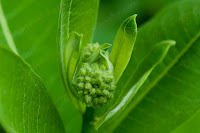 |
| Dogbane vs. milkweed, look for the hairs under magnification |
We had read about a bitterness associated with the plant and the sap, and possible poisonous characteristics of the sap. We also read some strongly worded arguments about the non-bitterness of milkweed. Most people who have actually gone out and really tried milkweed seem to agree that it is not bitter, and does not need to be boiled in 3 changes of water to make it safe to eat. We decided to go a safe middle route, and boiled our milkweed once for about 8 minutes. All parts we tried after a initial boiling-the shoots, flower buds, and pods-were very tasty and not bitter at all. I will admit that once we used the boiled parts in a recipe and the milkweed was cooked again, it tasted even better. Milkweed is a wonderful addition to recipes as a vegetable, it's flavor resembles green beans.
In the spring, we went to open areas that we knew had milkweed growing in them last year. Sometimes you can find the dead, dry stalks from last year. The shoots are best picked when they are 6-12 inches tall. At that stage their leaves are still partially closed along the stems. They are tender and can be gathered without a knife by pinching the stalks off. We boiled them and ate most of them plain with a pat of butter and a shake of salt. These are great spring vegetables.
Next come the flower bud clusters. We picked them when the clusters were still fairly tight, the stems of the flowers will elongate and the cluster will become much looser and floppier right before the flowers open. At this stage, the flower bud clusters look like broccoli. We boiled them about 8 minutes and tasted them with butter and a bit of salt. Again, they tasted a bit like green beans, only with a more velvety texture. Then we cooked them in a quiche and in soups, and they tasted even better. We did not try the open flowers, although they are edible.
The pods came very early this year with all of the rain in the spring and high heat this summer. Pods on different plants are all in different stages of readiness, so we can go out for multiple harvests. The pods we are gathering to eat are actually immature, the insides are completely white and the outside green shell is still tender. We picked pods between 1-3 inches long. Robert boiled them for 5 minutes, and some were popping open. We tried them plain, but the flavor was greatly improved when we then chopped and stir-fried them with soy sauce. I also took the boiled pods, split them along their seam, removed the white pre-silk, and stuffed them with a cream cheese, jalapeno and red onion mixture and baked them topped with breadcrumbs. I stuffed some other pods with buttered basmati rice mixed with the cooked pre-silk, and baked those in a yellow pepper sauce. The pods make another fantastic wild vegetable.








3 comments:
I love this post! We have lots of milkweed around, so this is a great asset. It will be fun to try some of these ideas :)
and.... Welcome to OBN! It is a great community.
Being that people all over the world are trying to grow milkweed to save the disappearing Monarchs, it's probably best not to destroy this plant, or disturb it's seeds.
Bob, while I appreciate your concern, I want to point out once again that milkweed is not endangered in Connecticut. We are a family of 3 people and we can only eat a little bit. We do not gather for commercial sales, only for ourselves. Our area of Connecticut has thousands of acres of fields filled with milkweed, we are not eating it all by a long shot. Chances are no matter how much milkweed there is, it is the overuse of chemicals like pesticides and fertilizers that are decimating the monarch population, not a family of 3 who gather a few meals worth of milkweed flowers, pods, or shoots.
Post a Comment